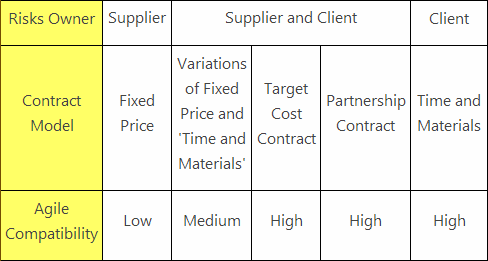
IT contracts – part 1
- Processes, standards and quality
- Technologies
- Others
In this article I would like to present the possible contract models and the Agile realisation compatibility juxtaposition.
When working in Agile team the close co-operation of business/client and team is essential (Agile Manifesto: „Customer collaboration over contract negotiation”). And this requires the total trust of the sides and real client’s commitment throughout all the time. Unfortunately, it does not always fit to common indentures. Let’s have a look at which contract models fit best to Agile.
Approach to contract
It is presumed that there are two different approaches to what is the contract’s aim:
1. The purpose of contract is to protect the sides from possible undesirable actions towards each other.
2. The purpose of contract is to establish proper mechanisms for both companies close co-operation.
Considering the above approach let’s have a look at the contract models in general. The division indication will be matching the risks to side or to client, and easiness of matching the contract to Agile type of work.
Considering the above approach let’s have a look at the contract models in general. The division indication will be matching the risks to side or to client, and easiness of matching the contract to Agile type of work.
Fast analysis of given table leads us to following conclusions:
- Time and materials fits to Agile, but at the same time means the supplier’s low risk, what means lower potential income
- Target Cost Contract also fits to Agile, the risk is for both sides equal, what means that supplier is able to earn more
- Fixed Price and its variations do not fit Agile this much, bring a lot of risk to supplier, but theoretically give the highest incomes
- Partnership Contract fits to Agile and means relatively low supplier’s risk especially in project initiation phase
Let’s have a closer look at mentioned above kinds of contracts.
Time and Materials
Is a kind of contract where the client pays to supplier for the working time (according to prearranged hourly rate) and used materials (e.g. using the software license). The executor’s hourly rate considers all costs and profit, calculated by the supplier.
The customer is fully exposed to the entire risk, while the supplier cares just for the people to co-operate properly with client, for the solution with desirable quality to be brought on time. Although, the only possible consequence for the executor can be not extending the agreement, or braking a contract, if it is possible.
Contracts of that type are usually when both sides trust each other – a client knows for what he pays and in his opinion the amount is fair enough. A supplier, on the other hand, is satisfied with the money he gets. Worth to mention what does the trust mean in such approach – on the one hand the client just trusts the supplier to do his best, on the other hand – the client does not want to make the supplier more responsible…
Fixed Price
Is a kind of contract where client and vendor agree on a steady fixed price for the operation of the service (bringing the solution). The price is estimated by supplier on the basis of the scope of work to be done. The constant price means the constant scope and the deadline.
The risk is almost entirely on the supplier, who has to deliver the solution on time.
Contracts of that type are mainly the result of lack of sides trust to each other and often evolve to other forms (if only the sides trust rises).
Variations of both
All possible modifications or mixing elements from fixed price contracts, or time and materials. I will present the possible options we can consider in one of the following articles.
Target Cost Contract
Is a kind of contract where both client and supplier share the risk. Both sides agree on the target cost, which arises from the constant amount of hours, which is to be given to deliver the solution, according to defined scope of work. In case of labour cost overspend the target price, then both sides incur the costs. Also, in case of supplier deliver the solution below the target price, the sides share profits (a client pays the contractual amount of money, arising from the needed amount of left hours).
Characteristic features of such contracts:
- Target pricing provides for change cost
- The sides share responsibility for the project results
- The contract is clear for both sides, including the vendor’s team
- The client and the supplier collaborate closely, collaboration is the key to success
- Negotiations, in case of target pricing overspending
Worth to mention how the price is defined:
- Both sides collaborate in identification, analysis, and estimation of all possible requirements
- Both sides estimate the change or enhancement of extent cost during the project duration
- Based on both previous elements the target cost is estimated
- The target profit is estimated, based on target cost (e.g. 20% of target cost)
- Both sides are aware of all details of estimations
Target Schedule Contract
Sometimes, there are projects where the time is way more important than costs. In such case the contract is made for the supplier to have the full freedom of an action (adding people to the project, buying ready-made indirect solutions, etc.) keeping in mind the deadline.
Partnership Contract
Is a kind of contract where defining service is way more important than the subject of contract itself.
Characteristic features of contracts:
1. Structure
- Discovery contract (check if working, short iteration, requirements not defined before – Umbrella or Framework Contract)
- Work released in stages:
- small stages
- each stage is an iteration
- often early stages are fixed price
- iteration scope depend on most pressing business needs and the professional judgment of the development team
- The scope not included in current iteration is non-negotiable
- The project may be ended after any iteration
- Different payment methods for iterations (time and materials, fixed price, etc.)
2. Form
- Characterises relations/services, not the subject of the matter itself
- Creates a framework for future contracts
- Fixed price/fixed scope for the beginning stages of project (in case when both sides are satisfied the turn to time and materials)
- Defining the high-level expectations
- Defining the copyrights ownership
- Possibility of negotiations before each iteration
- Defining mechanisms in case of conflicts (escalation, mediation and termination)
Summary
As we can see, the software-related services do not have to be limited just to the time and materials, or fixed price kind of contracts. There are many indirect forms and innovative approach to making contracts, basing not only on the subject of the contract itself, but mainly on the partners’ relations. In upcoming articles I will do my best to:
- show the possible indirect options
- describe broader rules of the fixed price contract in practice
- give the examples from the target/partnership group


